#bert haanstra
Explore tagged Tumblr posts
Text
youtube
Glas by Bert Haanstra won him the Oscar for Documentary Short Subject in 1959.
The film is a beautifully made, wordless contrast between the handmade crystal from the Royal Leerdam Glass Factory and the product of industrial bottlemaking machines.
The shots of the glassblowers' hands shaping the glass through rotation are perfectly matched to a chamber jazz score. The men puffing into blowpipes to inflate the glass visually echoing the soundtrack musicians blowing into their instruments. By contrast, the mechanized bottlemaking gets zero music, only a disembodied voice counting, to accompany its relentless production.
I always think of glassmaking as alchemy anyway. Sand plus soda ash plus limestone transmuted by heat and breath into a translucent shape that can be as fragile as a spider's web or as sturdy as a brick. This short film shows the wizards at work and clearly favors their craft over automation.
#bert haanstra#academy award#oscar#documentary short subject#glass#glassblowing#dutch films#alchemy#Youtube
3 notes
·
View notes
Link
Albert Haanstra was a Dutch director of films and documentaries. His documentary Glass (1958) won the Academy Award for Documentary Short Subject in 1959. His f...
Link: Bert Haanstra
0 notes
Text
Round One - Set 155


Glass worker by Rafael Roos
Description: black and white photo of a person working on glass at a oven. Propaganda: it makes me think of the short film "Glass" (from 1958) by Bert Haanstra, which Shows a glass factory set to jazz music and is a favorite of mine since I seen it the first time as a tween. (Link to it on youtube here)
Glass worker by Rafael Roos. Photography. The art is 9 x 12 cm. The art belongs to the Finnish Heritage Agency (and was accessed through the website finna.fi (link to the art here).
Right: Mesilä bicycle shop in 1951 by Räshid Nasretdin
Description: black and white photo a man rolling a bicycle rim, sparks fly.
Mesilä bicycle shop in 1951 by Räshid Nasretdin. Photography. The art is 30 x 43 cm. The art belongs to the Finnish Heritage Agency (and was accessed through the website finna.fi (link to the art here).
#image description in alt#Räshid Nasretdin#rafael roos#photography#finnish art#finnish artist#round one#polls#1950s#20th century
15 notes
·
View notes
Text

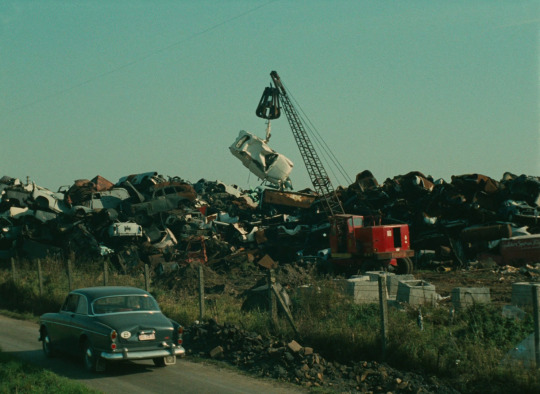
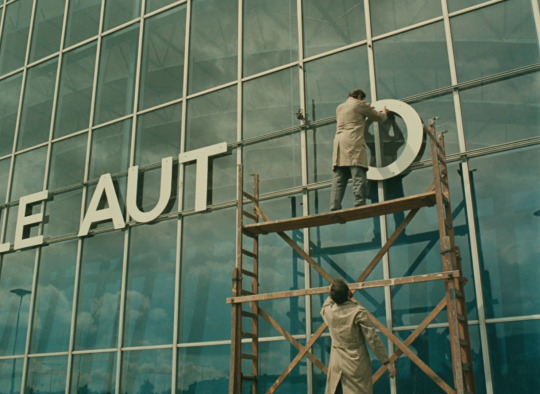

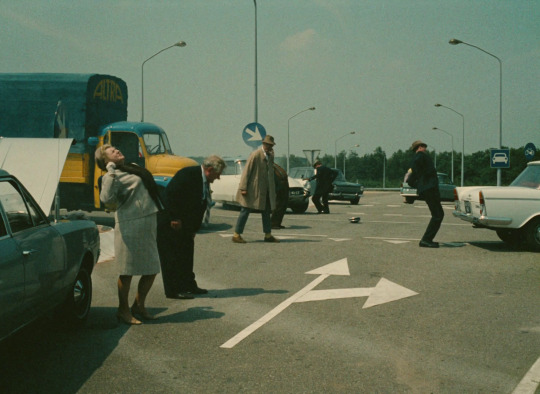

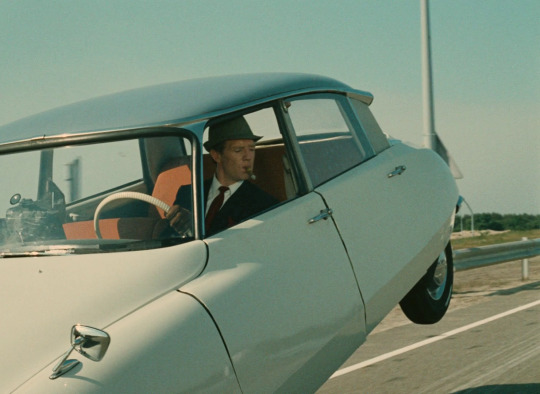
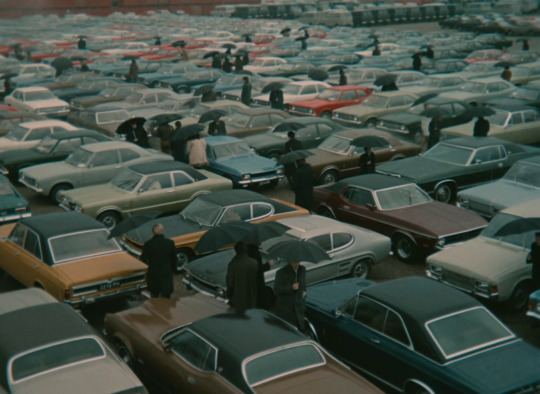
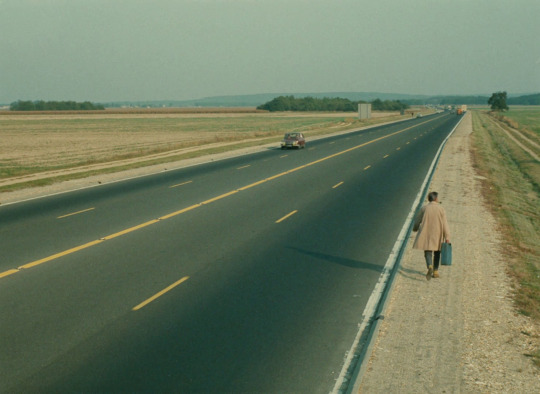

Trafic, 1971.
Dir. Jacques Tati | Writ. Jacques Tati, Jacques Lagrange & Bert Haanstra | DOP Eduard van der Enden & Marcel Weiss
20 notes
·
View notes
Text

Movies I watched this week (#178):
2 X Wojciech Jerzy Has + 2 X Bruno Schulz:
🍿 Bruno Schulz, "The Polish Kafka", is regarded as 'one of the finest Polish prose stylists of the 20th century'. Before being killed by the Gestapo in 1942, he published only 2 small works. Both were adapted to the cinema later on.
The Hourglass Sanatorium (1973) is a wild surrealist interpretation of Schulz's stories. An acclaimed masterpiece of Borgesian proportions, but where the magical realism is of the Eastern European type, played by poor Shtetl-Jews. A dark, decrepit nightmare, covered with spiderwebs, years before Terry Gilliam ploughed through the same insanities. Schrodinger time-shifts, mysterious doppelgängers, grotesque wax mannequins and lots of sensuality among the ruins. It's a heady, bizarro work of mythological unease. And the final dream scenes connect the story to the holocaust and the annihilation of this world, taking place in graveyards and on the shocking deportation lines. It's Heavy!
🍿 Accordion, Jerzy Has's first short, was how I discovered him. A wordless, bleak fable from 1947, about a son of a poor shoemaker who dreams about buying a used 'Harmonia'.
🍿 Street of Crocodiles on the other hand, the second Bruno Schulz adaptation, was a let down. Dark British stop-animation puppetry, wordless, confusing and in dirty back alleys. An experimental mood piece in a Jan Švankmajer style, but without the charm. M'eh. 1/10.
(Meanwhile I am listening to the music score for Kieślowski's Three Colors: Blue.)
🍿
Six by Sondheim, a 2013 documentary and my introduction to composer and lyricist Stephen Sondheim. Absolutely beautiful! (And I loved his Ethel Merman / Loretta Young anecdote...) 8/10.
I have to start searching for his full repertoire. (Or at least I should re-visit 'Marriage Story' one more time...)
🍿
2 by female directors:
🍿 On May 9, 1954, two days before the start of 'La Pointe Courte', her first feature film, Agnès Varda took a photograph of a naked man, a boy named Ulysse and a dead goat on the beach of Calais. (Photo Above). In 1983, she recreated that experience in the documentary Ulysse, an evocative reflection about the time machine of memory, history and art. It’s my 15th Varda film, and was as good as the best of them - 9/10. [*Female Director*].
🍿 Possibly in Michigan (1983) an avant-garde horror musical about cannibalism, a feminist revenge fantasy. Two women shopping for perfume at a department store, are being stalked by a masked serial killer. Artsy and disturbing. A complete review here. [*Female Director*].
🍿
The Browning Version, a British public school drama from 1951. Michael Redgrave gave a tremendous performance as a repressed and meek teacher, isolated and unloved. His contemptuous wife has an affair with a coworker, his nickname by his pupils is 'Himmler of the Fifth Ward', and on his last day of his last term, he's denied his pension. It's a story of failure and heartbreak.
🍿
Benoît Magimel X 3:
🍿 "...La Salope…… La Salope.... La Salooope..."
Magimel made his debut performance as a 12 year old delinquent in the quirky comedy Life Is a Long Quiet River, which tackled the question of Nature vs. Nurture in a wry and unexpected way. 2 babies get swapped at the hospital out of spite. One belongs to a rich family, the other to a poor one.
I never heard of it before, didn't know what to expect - and enjoyed it very much. 7/10.
🍿 The Bridesmaid, my 11th Amour Fou thriller by Claude Chabrol, made 6 years before his death. It started effortlessly and smooth, and was a delight to watch. But then Magimel meets and falls hopelessly in love with an enigmatic, 'unusual' woman, who's also a compulsive liar and a psychotic nutcase, and the rest just didn't work out. 3/10.
🍿 In Putain de Porte from 1994, 4 guys, including very young Vincent Cassel, Mathieu Kassovitz, and Magimel try to crash a party they were not invited to. M'eh.
🍿
3 by Dutch Bert Haanstra:
🍿 Glass, a short documentary from 1958, and the first Oscar win for The Netherlands. A highly-satisfying jazzy poem with terrific score, performed by The Pim Jacobs Quintet. My best film of the week - 10/10.
🍿 Zoo, made 3 years later, is similarly wonderful. Filmed with hidden camera, it draws parallels between the animals at the zoo and the many visitors who come to observe them, but really, behave in exactly the same ways. 9/10.
🍿 Fanfare was another successful comedy which he directed in 1958, and one which for decades, was “the most popular of all Dutch films”. It's a charming low-brow entertainment [what the Danes call 'Folkekomedie'] about a musical feud in a small touristy village. Its bucolic country all the way: Cows in the meadows, beer steins in the coffee hall, love in the haystacks, a trombone band, the whole nine yards. The only things missing were Gouda cheese wheels, wooden clogs and stork nests.
🍿
2 with Anne Miller:
🍿 I'm getting more and more enamored with old-fashioned musicals, especially from the technicolor era, and all the ones with Fred Astaire. He was such a happy dancer! Easter parade is a Pygmalion story with the usual power imbalance: He's 49, and Judy Garland is 26. But they were so wonderful! Ann Miller, (as was her custom I guess), played the the third wheel to their romance.
🍿 I think that Room Service was the only Marx Brothers comedy I haven't seen before. Their best comedies were masterpieces, but the weak ones were pitiful. The whole plot was about the three of them not able to pay their hotel bill, so basically it was "based on a true story". Ann Miller and young Lucille Ball served as background decorations. Jumpin' butterballs! 2/10.
🍿
My friend Simon is going through the classic works of Russian literature (Dostoevsky, Tolstoy, Etc.), and is currently heavy into Nikolai Gogol. So in sympathy I tried watching the 1926 silent Soviet version of The Overcoat. Unfortunately, I couldn't finish it.
🍿
2 juvenile comedies by Steve Pink:
🍿 "Excuse me, Miss, what color is Michael Jackson?"
In the opening scene of the gross-out guy comedy Hot Tub Time Machine, Craig Robinson pulls out a BMW key out of a dog's ass. Right off the bat, you know if this screwball time-machine story is for you. With ‘method actor’ Rob Corddry playing a raging asshole, (which he seems to be doing very well), and naked cameo of Megan Calvet-Draper. Raunchy but funny in parts. 7/10.
🍿 I shouldn't have tried to follow it up with his trashy teenage comedy Accepted. Jonah Hill, a year before 'Superbad', with about 100 lb. more, young Blake Lively, angry Lewis Blake and Dr. Frederick Chilton get together 1/2 a star (out of 10). For the rest, I could barely stay for half an hour, before having to turn it off. it was "Super Bad"!...
🍿
New discovery - The brilliant shorts of Arthur Lipsett!
🍿 Arthur Lipsett was a visionary Canadian avant-garde artist, who suffered from schizophrenia, and who eventually killed himself. His 1963 montage film 21-87 was a tremendous collage of discarded snippets found on the editing floor of the National Board Of Canada where he worked as an editor. 10/10.
🍿 Very nice, very nice, his very first film from 1961, was just as unique. It was nominated for an Oscar, and was adored by Stanley Kubrick, who subsequently offered Lipsett a job as the editor of the trailer for 'Dr. Strangelove'. Another 10/10.
🍿 Free Fall (1964) was even darker and more chaotic, with definite hints of psychosis. He had a brilliant sense of juxtaposition and collage, both sights and sounds.
🍿
"You made me the happiest juvenile delinquent in Baltimore!..."
First watch: John Waters’ most mainstream attempt Cry-Baby, a 1950's 'Squares vs. Hill-billies' teen rebel musical. Elvis + Grease + Rebel without a cause with Tracy Lords and Willem Dafoe and Iggy Pop and Joe Dallesandro. 3/10.
🍿
“Back to the salt mines…”
James Bond No. 2, From Russia with love, before the series got its footing. With blond villain Robert Shaw, and primitive levels of intrigues and suspense. Best producer fruit-name still goes to Albert R. Broccoli. 3/10.
🍿
More random bunch of acclaimed 10-minute shorts:
🍿 In the Darkness of Time, J-L Godard's 2002 collage of poetic images, juxtaposed into a mosaic of concepts: love, art, memory, death, humanity, destruction and cinema. He really was 'un poète' first and foremost.
🍿 René Laloux 1964 visual essay, Dead Times. A sardonic, surrealistic poem about Man's inherit need to kill everything around him. Like 'La Planète sauvage', the drawings are by Roland Topol, and the music is similar.
🍿 When the Day Breaks, another National Board of Canada Oscar nominated short, from 1999, about a humanoid pig who witnesses the accidental death of a humanoid rooster. 8/10. [*Female Director*].
🍿 Inspiration (1949), my second film by Czechoslovakian Karel Zeman (after ‘Invention for destruction’). A stop motion tale of a glass ballerina and a glass clown, the type of little figurines that used to be so popular then.
🍿 I think this is the closest to how the footage looked (2012) is an artsy but touchy Israeli short. A young man remembers the actual last day in the life of his mother, and how his father by mistake erased the video he had taken of her that last day.
🍿 Bluebeard, a fantastic 1901 film by Georges Méliès, about the serial killer and his eighth wife.
🍿Litany of Happy People (1971), my first by Slovenian Karpo Godina, of the Yugoslav 'Black Wave' cinematic movement. Experimental hippy documentary about the various minority ethnicities in some village.
🍿 Cathedral (1971), one of the earliest gay films that came after Stonewall. A poetic love session between three beautiful guys in a shrine of sheets, which eventually turns into a cathedral. Not for me, but okay…
🍿 Once Upon a Time there Lived a Dog, a 1982 Soviet folk tale about a dog and a wolf.
🍿
James Payne, curator of the channel 'Great Art Explained' gave a 51 min. exploration of Hieronymus Bosch's The Garden of Earthly Delights. A fascinating run-down, worth watching together with the detailed 'De tuin der lusten' project and Wikipedia. 8/10.
🍿
(My complete movie list is here).
6 notes
·
View notes
Text
नमस्कार,आज मेरे ब्लॉग का शुभारंभ है उसके लिए मैं खुद को शुभकामनाएं देता हूं । मैं एक MA in Mass Communication का छात्र हूं और अपने ब्लॉग की शुरुआत मैं अपने विषय से जुड़े मुद्दे से करता हूँ। मेरे कॉलेज के एक प्रोफेसर है जिनका शुभनाम श्री राम मनी त्रिपाठी है जो हमें Film Appreciation नामक विषय पढ़ाते है जिसमे संबंध सिनेमा से है। सिनेमा की ज़रूरत,सिनेमा का आगमन,सिनेमा का काम,सिनेमा की अच्छाई समाज के प्रति वगैरह बताते समय उन्होंने बीच मे खुद को रोकते हुए हमें एक documentary देखने को कहा जिसका नाम ZOO by Bert Haanstra है जोकि 11:03 मिनट की है और कहा कि इसे देख के आप बताइए कि ये छोटी सी documentary कहना क्या चाहती है क्योंकि सिनेमा से हमे संदेश ज़रूर मिलता है। हम,जो कि एमए के प्रथम सेमेस्टर के छात्र,हमे क्या ही पता चलता कि ये छोटी सी फ़िल्म क्या कहना चाह रही है। पर फिर भी हमने देखा और जैसा कि फ़िल्म का शीर्षक था उसी से मेल खाती पूरी फिल्म थी। इस फ़िल्म में दिलचस्पी के नाम पे एक ध्वनि थी जो कि बिल्कुल भी दिलचस्प नही थी।
तो उस छोटी सी फ़िल्म में हमे जो लगा देख के,कि, कुछ जानवर है जो अपनी दिनचर्या में लगे है, वो खेल रहे,कूद रहे,सो रहे,खा रहे और उन जानवरो को देखने आए दर्शक वो उन्हें देख रहे,हंस रहे,उनकी तस्वीर ले रहे,खुद को रिझाने के लिए उन्हें पत्थर मार रहे,उनको चिढ़ता हुआ देख कर खुश हो रहे। बस यही हमे समझ आया। तो हमलोगों ने सर को यही कहा कि सामान्य सी लघु चलचित्र है। तो हमारे सर ने कहा कि Bert Haanstra ऐसे तो कोई documentary बनाएगा नही,उसमें कुछ तो बात होगी। आगे उन्होंने बताया कि जब Bert उस चिड़ियाघर में गए होंगे तो उनकी कलाकारी आंखों ने वो देखा जो आम इंसान नही देख सकते और फिर उन्होंने अपनी टीम को बुला के पूरे चिड़िया घर मे स्पाई कैमरा लगवा के पूरी दिनचर्या को कवर किआ और उसे एक documentary का रूप दे दिया। Bert हमें ये समझाना चाहते है कि असल मे जानवर है कौन? वो जो पिंजरे के अंदर कैद है या वो जो पिंजरे के बाहर आज़ाद है। वो ऐसा इसीलिए कह रहे है क्योंकि जो काम जानवर कैद में राह के कर रहे है वो काम वो दर्शक आज़ाद हो के कर रहे है। जानवर खा रहे है और दर्शक भी खा रहे,जानवर सो रहे और दर्शक भी सो रहे,जानवर खेल रहे दर्शक भी खेल रहे,जानवर प्रेम कर रहे और दर्शक भी वही कर रहे। कुछ भी अंतर न होने के बावजूद भी एक बहुत बड़ा अंतर है और वो है स्वतंत्रता। चाहे वो खाने की हो,खेलने की हो,सोने की हो,प्रेम की हो,मनोरंजन की हो। जानवर जो कर रहे उन्हें उसकी आज़ादी नही है पर हम इंसानो को हम दर्शको को पूरी आज़ादी है। दर्शक जानवर को पत्थर मार के उसके चिड़चिड़ेपन को देख कर सुख की अनुभूति करता है पर अगर जानवर करे तो उसे गोली मार दी जाती है,उसके साथ अन्याय होता है। देखा जाए तो असली जानवर वो नही को पिंजरे में कैद है बल्कि असली जानवर हम है जो आज़ाद है। Bert Haanstra ने बहुत ही शानदार और प्रेरणादायक documentary बनाई है और अगर समय मिले तो ये छोटी सी documentary आप देखे जो कि आज लगभग हर मीडिया स्कूल में दिखाई जाती है। धन्यवाद



1 note
·
View note
Photo





Glass (Haanstra, 1958)
5 notes
·
View notes
Photo

Mirror of Holland (1950)
5 notes
·
View notes
Photo






Bert Haanstra - The Netherlands (1983)
65 notes
·
View notes
Video
youtube
Panta Rhei (All Things Flow)
short experimental film directed by Bert Haanstra, 1952
11 notes
·
View notes
Text
HET EIGENZINNIGE KUNSTZINNIGE GEZIN HAANSTRA

De eerste helft van de 20e eeuw. Het culturele landschap ligt overhoop. In de grachtengordel. Want daar gebeurt het. Het achterland slaapt. In Twente wijden de Tukkers zich aan de textiel en het metaal, landbouw en veeteelt. En is minder bezig met de innerlijke aandrang en de gemeenschappelijke kunstzinnige tijdgeest. Het is daarom opmerkelijk dat een van oorsprong Fries gezin er welhaast voltallig een eigen weg gaat. In de kunst. In dat tamelijk cultuurarme gewest. Zich daarbij laat inspireren door de diverse eigentijdse stromingen in de moderne kunst. Zich niet laat afleiden door de heersende publieke belangstelling voor het realisme en de figuratieve kunst. Het gezin Haanstra is eigenzinnig, maar vooral kunstzinnig.
In de uitgave “de Haanstra’s, vier schilders uit één gezin” lees ik dat vader Folkert sr. zich aan de kweek laat scholen tot onderwijzer. Met zijn jonge vrouw trekt hij diep Overijssel in om zich uiteindelijk te vestigen in Goor. Er worden vier kinderen geboren, jongens.
Folkert sr. heeft als hobby tekenen en besluit de LO-akte te halen. Hij krijgt kunde aan kunstenaars en leert de basis van het schildersvak. De belangstelling voor kunst slaat om in voorliefde. Maar er moet brood op de plank blijven komen voor het zeskoppige gezin, dus blijft Folkert sr. tot zijn vervroegde pensioen voor de klas. Deze hang naar kunst zet zich door in zijn kinderen, die de drang hebben ook die richting in te slaan. Oudste zoon Johan komt terecht op de kunstacademie. Vader Folkert kan zo in het schilderen mee groeien met zijn zoon en reikt door verdere zelfstudie van amateurschilder naar een prijswinnend kunstenaar.
Vader ziet zijn zonen niet in zijn voetsporen treden, het vak van onderwijzer. Hij had dat graag gewild. Johan gaat na de HBS op voor een opleiding tot tekenleraar aan de Rijksacademie. Hoewel hem gezien zijn talent wordt aangeraden zich in te schrijven voor de Prix de Rome besluit hij anders, gaat in militaire dienst en bouwt daarna een praktijk als portretschilder op. Zoon Wim krijgt na de HBS een baan op een adviesbureau. Hij bekwaamt zich tot op hoog niveau in de kunst van de damsport en schildert af en toe in zijn vrije tijd. Bert volgt zijn vader, maar de kweekschool houdt niet zijn interesse. Voordat hij achter de filmcamera werk vindt is hij bezoldigd tekenaar. Maar jongste zoon Folkert jr. volgt toch de raad van zijn vader, wel droomt hij van een toekomst als kunstenaar.

En dan is het oorlog, het land wordt overvallen, de bezetter neemt zijn posities in. Tijdens de bezetting ontwikkelen de vader en zijn drie zonen zich verder in de kunst. Ze onderhouden contacten met andere kunstenaars, ze helpen elkaar aan schaars te krijgen schildersmateriaal en dromen van een betere toekomst. “Een tijd waarin de oude maatschappij en cultuur, die geleid had tot oorlog en verderf, zou worden vervangen door een nieuwe tijd”, lees ik in de voor het boek geschreven tekst van kunsthistorica Peggie Breitbarth. “Een tijd van vrijheid en rechtvaardigheid, een tijd met kansen en waardering voor kunst en kunstenaar.” Want in het gezin Haanstra is in de opvoeding gelijke aandacht voor de drieslag hoofd, hart en handen samen met maatschappelijk bewustzijn en verantwoordelijkheidsgevoel. Dus de hunkering naar een nieuwe tijd en kunst in vrijheid is ingebakken bij de jongens en hun vader.
In ”de Haanstra’s, vier schilders uit één gezin” gaat schrijfster Breitbarth uitgebreid in op de biografie van het gezin. De grootouders die aangetrokken door de enorme opbloei van de bouwnijverheid van Friesland naar het westen komen. Over de ouders die door een aanstelling als hoofd aan een openbare school van Amsterdam naar Overijssel verhuizen en in Twente belanden. Over het wel en wee van de vier zonen tijdens opleiding, studie en werk. De zin van de vader en de drie zonen om te schilderen en daarin levenslust en levensonderhoud te vinden.

Het is een onderhoudend verhaal om te lezen hoe de Haanstra’s zich staande houden in de kunstwereld; de moderne kunst in Twente laten beginnen in Goor. Want hoewel ze wel teruggrijpen op de kunst van voor hun tijd, letten ze op wat er in hun dagen gebeurd en kijken ze vooral ook vooruit. De Haanstra’s vragen in hun werk respect voor een kunst die zich in vrijheid mag ontwikkelen, ook al is het resultaat ongewoon, soms vreemd en niet direct te volgen voor de doorsnee kijker. Een recensent schrijft “Schrikt u niet: er zijn zelfs kubistische werken, en non-figuratieve!” naar aanleiding van een tentoonstelling in 1953. Vader en zonen schuwen de moderne stijlen niet en laten deze doorwerken in hun eigen kunst.
De vier Haanstra’s hebben in het boek ieder een afzonderlijk hoofdstuk. Elk een korte inleiding over individueel leven en werken. Daarnaast een uitgebreide inkijk in de oeuvres, van schilderijen en tekeningen. Daarin valt het op dat alle vier de beschreven Haanstra’s een bijzonder talent bezitten. Ieder op een eigen manier. Vader Folkert sr. als autodidact in eerste instantie enigszins behoudend. Maar naarmate hij door zelfstudie meer en beter stijlen en techniek onder de knie krijgt, gaat hij experimenteren met kleur en vorm. Hij groeit van naïef tekenaar uit tot beschouwend schilder.

De scholing van Johan vindt een weerslag in zijn vroege werken. Diverse portretten tonen zijn kundigheid in het observeren van mensen. Maar later werpt hij zich meer op de verstilling van het landschap. De vereenvoudiging van de veelvormigheid van de omgeving. Bedachte plekken geven abstracte plaatsen weer. De droombeelden zijn speels en expressief in de geschilderde kaders gezet. Johan lijkt het landschap in het vierkant van zijn handen te vatten, de omgeving in kleur en vlak te vormen tot een handzaam beeld.
Bert is tevens een verdienstelijk portrettist, die de academische scholing in zijn werk laat doorklinken. Daarnaast oefent hij zich in het stilleven, maar is toch liever bezig met fotografie en film. Zijn tekentalent komt van pas bij het schrijven van de storyboards voor zijn latere rolprenten. Bert Haanstra wordt de Filmer van Nederland. Door zijn succesvolle overstap naar de filmkunst blijft de schildersezel verder ongebruikt.

De jongste Folkert bekwaamt zich naast zijn werk in het onderwijs in de schilderkunst. Eerst uit liefhebberij, maar later op de academie ontwikkelt hij zich nader en wordt vakdocent. Hij wordt lid van het Drents Schildersgenootschap en stuwt deze van vriendenclub op tot kunstenaarsvereniging. Hij is schilder en illustrator en ontwerpt mozaïeken en wandschilderingen voor scholen, kantoren en overheidsgebouwen. Speels en eenvoudig; kleurige vogels, vissen en planten. Toegankelijk voor een groot publiek laat hij de beschouwer volop meekijken. Zijn onderwerpkeuze is veelzijdig, maar toont vooral het landschap.
Net als vader en broer Johan verdiept Folkert jr. zich gaandeweg ook in het vereenvoudigen van de zichtbare werkelijkheid. De werken die hij maakt kort voor zijn plotselinge dood in 1985 zijn van een romantische schoonheid en tonen een idyllisch versimpeld landschap. Bert valt bij de andere Haanstra’s enigszins uit de toon, omdat hij als schilder niet aan die abstracte beeldtaal is toe gekomen. Zijn ontwikkeling in de beeldende kunst stopt op het moment dat hij gaat filmen.

Het boek “de Haanstra’s” geeft een beschrijvend inzicht en een beeldende kijk op dit bijzondere Twentse gezin. Vier levens in dienst van de teken- en schilderkunst. Waarvan één zich werpt op de filmkunst en qua landelijke bekendheid de anderen overschaduwd. Maar alle hebben een opmerkelijk talent om originele kunst te maken. “Vier schilders in één gezin, vier talenten, vier verschillende én verwante karakters.” Gezien deze complete uitgave qua biografie in woord en beeld zou je kunnen spreken over de Haanstra school. De verschillende gezinsleden hebben in hun werken samenhang. Het werk relateert, het maakt verbinding. Alsof vader over de schouder van de zoons kijkt. De zoons meekijken wanneer vader aan het werk is. De zoons bij elkaar het werk afkijken. Het werk heeft verwantschap, als familie door het kunstbloed dat door de culturele aderen stroomt. De familiekwaal is aangeboren, een van nature ingesleten talent gestimuleerd door de opvoeding.
De Haanstra’s, vier schilders uit één gezin. Samenstelling Henk Lassche en Marthe Koning. Tekst Peggie Breitbarth. Stichting Schilderkunst EE 84 en Waanders Uitgevers, 2021.
https://www.waanders.nl/nl/de-haanstras-vier-schilders-uit-een-gezin.html
#folkert haanstra sr#folkert haanstra jr#bert haanstra#johan haanstra#peggie breitbarth#vier schilders#waanders uitgevers
0 notes
Text
Film Toen: Fanfare van Bert Haanstra
Cultureel nieuws: 'Film Toen: Fanfare van Bert Haanstra'
WIERINGERWERF – Zaterdagmiddag 18 december 14:00uur is er weer een editie van Film Toen, deze keer in de Theaterzaal van de Cultuurschuur in Wieringerwerf. Deze zaal is “Corona-Proof”. Het is tijd voor een onverslijtbare klassieker van Bert Haanstra: Fanfare. Deze film focust op één van die vele ruzietjes waar Nederland groot in is. Prachtig, liefdevol gefilmd, in romantisch zwart-wit, met een…

View On WordPress
0 notes
Video
youtube
Glas by Bert Haanstra
Glas is a 1958 non-verbal documentary short by Bert Haanstra that contrasts glassblowing techniques used inside the Royal Leerdam Glass Factory with more modern industrial machines. The first half shows several men at work using traditional glassblowing to create ornate objects like vases and mugs set against jazz music, while the second part shifts abruptly into the mechanized world of industrial glass production set to a whimsical score of more synthesized music. Also, there’s a ton of great smoking! It’s a really unusual little film that went on to pick up an Oscar for Documentary Short Subject in 1959.
7 notes
·
View notes










